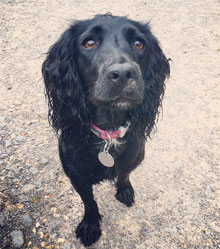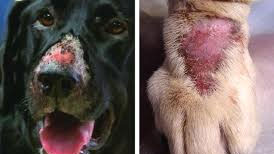Alabama Rot Warning & Symptoms
This article was original posted on 11th April 2016 but as Alabama Rot is now sadly and worryingly sweeping across the UK, we have decided to do an urgent update.

Eleven outbreaks of the disease have been confirmed across the UK this year alone. The latest case was reported in the West Midlands.
One of the first cases in the UK was in December 2015. After a fun walk in the woods, two cocker spaniels contracted Alabama Rot. Both dogs developed skin lesions but four days later one of the dogs, Pippa (pictured), started to show signs of kidney damage. Sadly, despite intensive treatment, the disease had taken over and she could not be saved.
What is Alabama Rot?
Cutaneous and Renal Glomerular Vasculopathy (CRGV or ‘Alabama Rot’) causes lesions on the skin and occasionally in the mouth, which can look like bites, sores, wounds or stings. Some dogs go on to develop life-threatening kidney failure.
Unfortunately, despite numerous treatment options, prognosis is still very grave. If a dog with CRGV develops kidney injury there is a ninety percent fatality rate.
Any age, sex or breed of dog can be affected. CRGV has not been seen in animals other than dogs. Owners of affected dogs have not been seen to be affected by this illness.
Symptoms

Mark Taylor, clinical director at Avonvale Veterinary Centres, has urged dog owners to be aware of symptoms, which can include sudden swelling or soreness on the skin.
"Early symptoms include sores and skin lesions, typically below the knee or elbow, which are not wounds from an injury. The sores show as a swelling, a patch of red skin or a defect such as an ulcer. From then, affected dogs can develop signs of kidney failure which can include vomiting, reduced appetite and tiredness."
What causes Alabama Rot?
More CRGV cases are seen between November and May than between June and October, suggesting a possible Winter / Spring seasonality, however the cause still remains unknown and investigations are ongoing.
An environmental cause for this disease is considered possible but it has not been proven to date. Recent work suggests that plants are an unlikely trigger and many other possible causes such as common bacterial infections and exposure to toxins have been ruled out.
More recently there have been thoughts that the disease could be picked up on the paws and legs while on muddy walks. Dog owners are therefore advised to wash mud off their dogs after muddy woodland walks.
With this lack of knowledge about the causes, the best advice would be to take your dog to the vet immediately if they develop unexplained sores or lesions and seem unwell.
Pledge for Pippa
Following the heart-breaking loss of her dog Pippa, owner Jessica is raising money into research for this disease. Investigations into diseases and their treatments are extensive and more money needs to be donated towards research.
To donate, please visit the NFDog Research Fund, a fund set up to facilitate further investigations into Alabama Rot https://www.newforestdog.org.uk/nfdog-research-fund
All money raised will be donated to Anderson Moores' Veterinary Specialists to pay for the development of new diagnostic tests, investigation of the causes of the disease and ultimately the development of more effective treatments which could help numerous dogs in the future.
By Jenny Prevel
© D for Dog www.dfordog.co.uk
This article belongs strictly to D for Dog and we do not authorise the copying of all or any part of it.

Our son's pup showed all the signs of AR last week so I warned the local dog walkers of a suspected case. The vets were convinced but the tests came back negative and they don't know what is wrong with him. All dog walkers, regardless of geographics should check their dogs paws daily to catch any symptoms early.
It would be useful to see pictures of what the lesions, or marks look like so you know what you are looking for in your beloved pets.
Could this get in-between the pads my dog got similar raising like the one of the paw only your picture showed the top of the paw mine as I say behind in-between the pads deep centre. My vet was most unsure as to it and he prescribe anti biotic and after a few days it went so could anyone tell me whether it could have been
So if you catch it in time can vets do anything to stop it progressing to the kidneys?